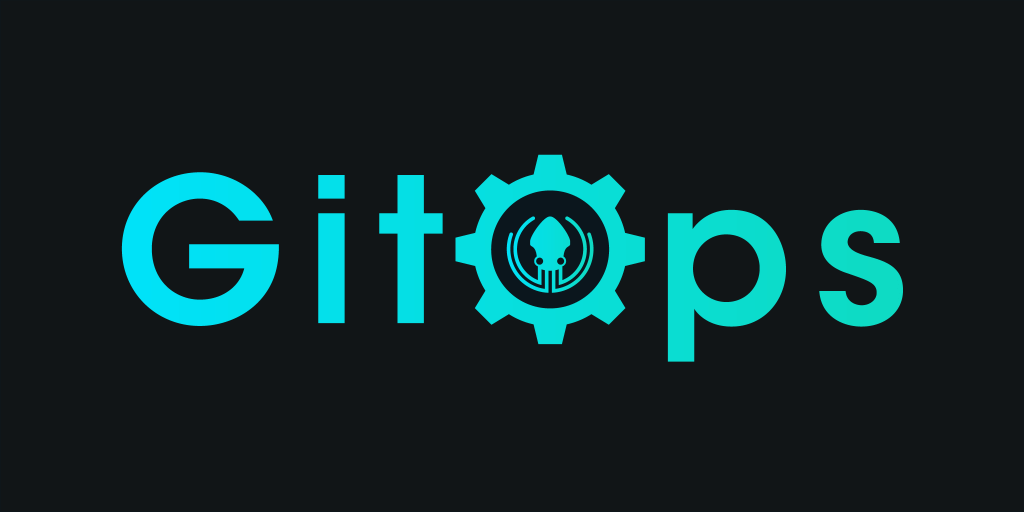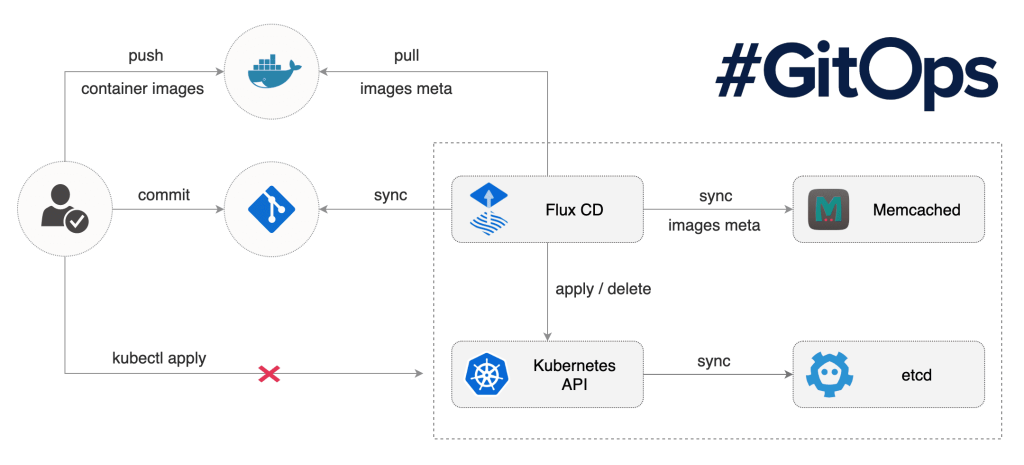What is GitOps ?

GitOps is a modern approach to managing infrastructure and applications by treating their desired state as code stored in Git repositories. It leverages Git’s strengths of version control, collaboration, and auditability to ensure consistent and reliable deployments.
Key Aspects of GitOps:
- Declarative configuration: You define the desired state of your system in manifests (e.g., YAML files) within a Git repository.
- Git as the single source of truth: All configuration changes happen through pull requests in Git, ensuring collaboration and traceability.
- Automated reconciliation: Tools like ArgoCD continuously compare the desired state with the actual state and automatically reconcile any discrepancies.
- Self-healing infrastructure: If the system deviates from the desired state, tools automatically bring it back into compliance.
Top 10 use cases of GitOps?
Top 10 Use Cases of GitOps:
- Simplified deployments: Streamline deployments and configuration changes through declarative manifests and automated workflows.
- Consistent configurations: Ensure consistency across development, testing, and production environments by managing the desired state centrally.
- Rollback capabilities: Easily revert to previous deployments if issues arise by leveraging Git’s version control features.
- Rollout strategies: Implement safe and controlled deployments with canary deployments, blue-green deployments, and rollbacks.
- Multi-cluster management: Manage applications across multiple Kubernetes clusters centrally for large-scale deployments.
- Self-service deployments: Empower developers with self-service capabilities to deploy and manage their applications through Git.
- CI/CD integration: Integrate GitOps with your CI/CD pipeline for automated deployments triggered by code changes.
- Enhanced security: Utilize Git’s access control and auditing features for secure configuration management.
- Declarative infrastructure management: Manage both application configurations and infrastructure alongside using GitOps principles.
- Customizable workflows: Tailor GitOps tools to your specific needs through plugins and extensions for advanced functionalities.
Benefits of GitOps:
- Efficiency: Streamlined deployments and reduced manual configuration errors.
- Reliability: Ensures consistent configurations and self-healing capabilities.
- Flexibility: Customizable deployments and workflows adapting to diverse needs.
- Security: Improved security through Git’s access control and auditability.
- Scalability: Supports large-scale deployments and multi-cluster management.
What are the feature of GitOps?
While GitOps isn’t a software itself but rather a methodology, it allows for leveraging tools to implement its principles. As such, the features will depend on the specific tool you choose, but here are some common features generally associated with GitOps:
Core Features:
- Declarative configuration: Define the desired state of your system (infrastructure, applications) in manifests (e.g., YAML files) stored in Git repositories.
- Git as the single source of truth: Manage all configuration changes through Git, ensuring collaboration, version control, and auditability.
- Automated reconciliation: Tools like ArgoCD, Flux, or Jenkins X continuously compare the desired state with the actual state and automatically apply changes needed to reconcile any discrepancies.
- Self-healing infrastructure: If the system deviates from the desired state, the tools automatically bring it back into compliance through automated deployments or configuration updates.
Advanced Features:
- Rollout strategies: Implement safe and controlled deployments with canary deployments, blue-green deployments, and rollbacks.
- Multi-cluster management: Manage applications and infrastructure across multiple clusters for large-scale deployments.
- Self-service deployments: Empower developers with self-service capabilities to deploy and manage their applications through Git-based approvals and workflows.
- CI/CD integration: Integrate GitOps with your CI/CD pipeline for automated deployments triggered by code changes.
- Infrastructure as Code (IaC): Manage both application configurations and infrastructure alongside using GitOps principles for unified configuration.
- Security: Leverage Git’s access control and auditing features for secure configuration management and enhanced security posture.
- Monitoring and visualization: Tools often offer dashboards and integrations for monitoring deployments, infrastructure health, and audit logs.
Additional Noteworthy Features:
- Extensibility and flexibility: Some tools offer plugins and extensions to customize workflows and adapt GitOps to specific needs.
- Community-driven: Many GitOps tools are open-source with active communities, promoting continuous development and support.
This is not an exhaustive list, and features will vary depending on the chosen tool and its version.
How GitOps works and Architecture?

GitOps operates on a core principle: treating the desired state of your infrastructure and applications as code stored in Git repositories. Tools then help automate and reconcile this desired state with the actual state in your environment, ensuring consistency and reliability. Here’s a deeper dive into its workings and architecture:
Workflow:
- Desired State Change: You modify configuration files (manifests) defining the desired state of your system within a Git repository.
- Trigger and Detection: GitOps tools like ArgoCD, Flux, or Jenkins X monitor the repository for changes and detect new commits.
- Manifest Parsing: The tool parses the manifests to understand the desired state of your infrastructure and applications.
- State Comparison: The tool compares the desired state with the actual state of your system, often by querying Kubernetes clusters or cloud providers.
- Discrepancy Reconciliation: If differences exist, the tool triggers actions to reconcile the states. This might involve deploying new resources, updating existing ones, or deleting outdated configurations.
- Automated Actions: Deployments, configurations, and even rollbacks can be automated based on pre-defined rules and workflows.
- Continuous Monitoring: The tool continuously monitors both the Git repository and the system state, ensuring ongoing reconciliation and self-healing capabilities.
Architecture:
- Git Repository: Serves as the single source of truth for desired state definitions, ensuring version control and collaboration.
- GitOps Tool: (ArgoCD, Flux, Jenkins X) Acts as the central hub, monitoring Git repositories, parsing manifests, comparing states, and triggering reconciliation actions.
- Kubernetes Cluster (or other target environments): Where your infrastructure and applications reside, managed by the GitOps tool to match the desired state.
- Additional Components (optional): Depending on the tool and setup, there could be external Git servers, API servers, controllers, or integrations with CI/CD pipelines.
Key Concepts:
- Declarative Configuration: You describe what you want, not how to achieve it, relying on the tool to handle the execution.
- Reconciliation Loop: The core mechanism continuously checking and correcting any discrepancies between desired and actual state.
- Self-Healing: Deviations from the desired state automatically trigger corrective actions for robust management.
- Version Control and Auditability: Git provides version control and audit trails for all configuration changes.
How to Install GitOps it?
GitOps itself isn’t software you install, but rather a methodology using specific tools to implement its principles. The installation process will depend on which tool you choose. Here’s a general overview for some popular options:
1. ArgoCD:
- Self-hosting:
- Manual installation: Requires technical expertise and involves installing various ArgoCD components on your Kubernetes cluster.
- Helm charts: Simpler method using pre-configured Helm charts, but offers less flexibility.
- Managed platforms:
- ArgoCD Cloud: Hosted ArgoCD service by the ArgoCD project, easy to set up but requires a subscription.
- Other managed Kubernetes platforms: Cloud providers and third-party services offer managed ArgoCD installations within their platforms. Explore options from AWS, Azure, Google Cloud, DigitalOcean, etc.
2. Flux:
- Self-hosting:
- Manual installation: Similar to ArgoCD, requires technical expertise for manual installation on your Kubernetes cluster.
- Helm charts: Available for simpler installation using Helm charts.
- Managed platforms:
- Flux is primarily focused on self-hosting, but some cloud providers offer limited managed options or integrations.
3. Jenkins X:
- Self-hosting:
- Jenkins X requires installing Jenkins and its X extensions on your Kubernetes cluster.
- Managed platforms:
- Limited options available due to its self-hosting focus. Explore community resources or cloud provider offerings for potential integrations.
Choosing the right tool:
- Technical expertise: Self-hosting requires more technical knowledge, while managed platforms are easier to set up.
- Control and flexibility: Self-hosting offers more control and customization, while managed platforms prioritize ease of use.
- Cost: Self-hosting can be more cost-effective for certain scenarios, while managed platforms typically involve subscription fees.
- Infrastructure: Choose a tool compatible with your existing Kubernetes cluster and infrastructure setup.
Basic Tutorials of GitOps: Getting Started

GitOps is a methodology for deploying and managing infrastructure and applications declaratively using Git as the source of truth. Here are some step-by-step basic tutorials to get you started:
Prerequisites:
- A basic understanding of Git and Kubernetes
- A Kubernetes cluster (local or managed)
- Kubectl configured to access your cluster
- A chosen GitOps tool (e.g., ArgoCD, Flux, Jenkins X)
Step 1: Simple Web Application Deployment with ArgoCD:
- Set up your Git repository:
- Create a new Git repository to store your application manifests (e.g., deployments, services).
- Add manifest files for your desired web application (e.g., a simple Nginx deployment).
- Install and configure ArgoCD:
- Follow the instructions provided in your chosen tool’s documentation (e.g., Helm chart for ArgoCD).
- Configure ArgoCD to connect to your Git repository.
- Connect your application to ArgoCD:
- In the ArgoCD web UI, add a new application and specify the URL of your Git repository.
- Configure other settings like namespace and environment (optional).
- Sync your application:
- Click the “Sync” button in ArgoCD to deploy your application based on the manifests in your Git repository.
- Verify that your web application is running in your Kubernetes cluster (e.g., using
kubectl get pods).
Step 2: Infrastructure Management with Flux:
- Set up your Git repository:
- Create a Git repository to store your infrastructure configuration files (e.g., Kubernetes manifests, Helm charts).
- Add manifest files for your desired infrastructure resources (e.g., deployments, services, namespaces).
- Install and configure Flux:
- Follow the instructions for your chosen platform (e.g., Helm chart for Flux on Kubernetes).
- Configure Flux to connect to your Git repository and target your Kubernetes cluster.
- Deploy your infrastructure:
- Flux automatically monitors your Git repository and applies changes to your Kubernetes cluster whenever you commit new configurations.
- Monitor the Flux logs and cluster resources to verify successful deployment.
Note:
- These are simplified examples, and the specific steps may vary depending on your chosen tools and configurations.
- Consider security aspects when implementing GitOps in production environments.
- Mutual of Omaha: Selection and Interview process, Questions/Answers - April 15, 2024
- AES: Selection and Interview process, Questions/Answers - April 15, 2024
- Amphenol: Selection and Interview process, Questions/Answers - April 15, 2024

